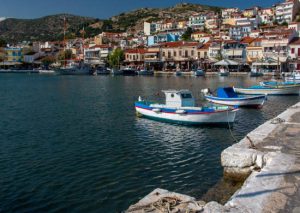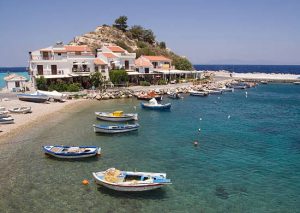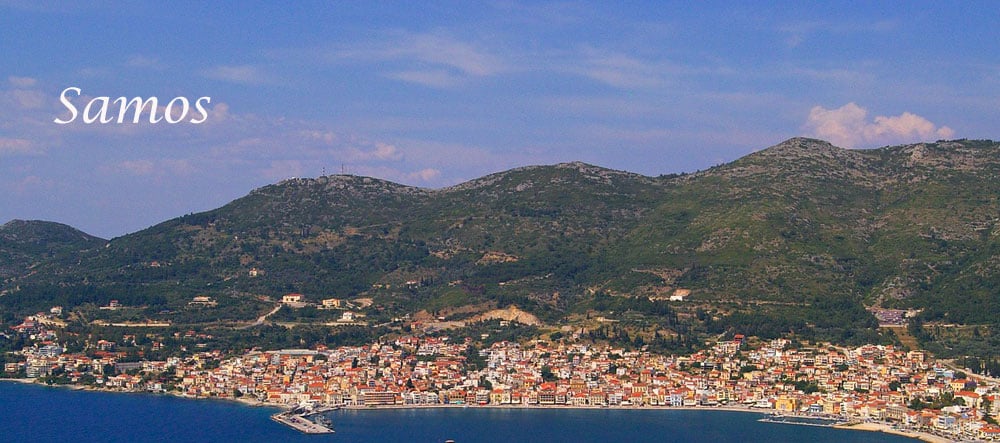Towns and villages of Samos

Samos’ settlements range from coastal hamlets that seem to spill into the azure waters of the Aegean to hilltop villages offering panoramic views of the sea and the surrounding landscapes. Each has its own unique character and story. Pythagorio, for instance, stands on the ancient ruins of the city of Samos, bearing the name of the island’s most famous son, the mathematician Pythagoras. Its harbour and the adjacent ancient ruins serve as reminders of a time when Samos was an influential maritime and cultural hub.
Further inland, the settlements of Manolates, Vourliotes, and Ambelos, among others, exude a traditional charm, with their narrow winding streets, stone houses, and time-honoured tavernas. Here, amidst the olive groves and vineyards, time seems to move at a more leisurely pace, allowing visitors to soak in the essence of authentic island life.

Furthermore, the island’s settlements have always been integral to its economic activities. Historically, many of these villages played vital roles in Samos’ thriving trade, especially in wine and olive oil. Even today, they continue to support the island’s economy, with many establishments showcasing locally made products, from delectable sweets to handcrafted goods.
In essence, the villages of Samos are more than just habitable spaces. They are repositories of the island’s soul and history. Exploring them offers a deeper understanding of Samos, as one navigates the delicate balance between its illustrious past and the vibrancy of the present. For the intrepid traveller, each village and settlement on this enchanting island promises a unique experience, replete with memories that linger long after the journey ends.
Vathi
Vathi is located very close to the city of Samos. It is one of the oldest villages, which maintains its traditional character with its beautiful houses, narrow streets and picturesque neighborhoods. It is worth visiting the buildings of the Primary school and the Community Shop. As well as the churches of Agia Kara and Evangelistria with their excellent frescoes and especially the church of Ai Giannakis. It is a two-aisled church with domes, dedicated to Agios Nikolaos and Agios Ioannis the Forerunner, dating from 1799.
Ano Vathi is one ne of the oldest settlements of the island that largely preserves its traditional character with beautiful houses, cobblestones, picturesque squares and many churches. A characteristic pole of attraction is the double-aisled church of “Ai Giannaki” from 1799 and the eponymous open-air theater where cultural events are organized.
Karlovasi
It is considered the commercial center of the island and is 32 km from the capital and 37 km from the airport. It has a large port, many government services and an excellent market. A city with a rich past, which is recorded in its very appearance, in the Hegemonic Megaron, in Hatziyanneio, in the neoclassical buildings in the settlements of Ormos and in the Port, in the imposing tanneries, in the School of Commerce, in the churches. All make up an image that testifies to its history and rich cultural tradition. It consists of the Old, New and Middle Karlovasi settlements, as well as the Port and Ormos.
Kokkari
Picturesque, with unique beaches, Kokkari is one of the most beautiful destinations in Samos and receives thousands of visitors every year. It is 10 km from Samos and 28 km from the airport. Narrow alleys, shops of special aesthetics, places of catering and entertainment, offer relaxation and dream vacations. In Kokkari, the green is combined with the blue of the sea, as the dense vegetation reaches all the way to the shores.
Marathokampos
Marathokampos is built at the foot of Kerki and around the bay of the same name and combines mountain and sea. A picturesque village with strong traditional elements, it dominates the southwest side of Samos and is 45 km from the capital and about 30 km from the airport. Cobbled streets, stone houses, traditional fountains, small squares and churches all untouched by time. Near Marathokambos is the cave of Pythagoras.
Mytilinii
Mytilinii are located in the eastern part of the island and at a distance of 12 km from the city of Samos. The village is built amphitheatrically in the middle of the Chisio valley. It is one of the largest and most important villages of Samos. Its picturesque square with its small cafes-taverns gathers many visitors in the summer months in particular. At a distance of 3 km from Mytilinii is the Monastery of Agia Triada, the newest monastery of Samos. For movie lovers, in a magical courtyard surrounded by greenery and flowers, there is a summer cinema.
Pythagorion
The idyllic Pythagorion is built on Ancient Samos and is 14 km from the capital and 4 km from the airport. Its archaeological, cultural and historical importance is recognized worldwide, since it has been declared a World cultural monument by UNESCO. The architectural construction of Pythagoras, the stone-built streets, the aesthetics, the picturesque districts and the traditional carnagio, together with the tourist infrastructure and the services provided, attract thousands of visitors every year. The statue of the Great Teacher, Philosopher and Mathematician Pythagoras dominates the harbor.
Kontakiaika
Kontakaiika is located in the northern part of Samos, 4 km from Karlovasi. The village is built at the foot of Karvounis and has a very beautiful view. It has a large arable area with vegetables, which reaches up to the plain of Karlovasia. To the west of the village and at an altitude of 950 meters is the site of Kastrovouni, where the ruins of a Genoese castle are located. Very close to the village are the settlements of Agios Nikolaos and Agios Dimitrios, as well as the picturesque port of Agios Nikolaos, which has been developing for tourism in recent years.
Kosmadei
Kosmadei are located in the northwestern part of Samos, at a distance of 12 km from Karlovasi. The village is built on the slopes of Kerki and has an amazing view towards the sea. An attraction of the area is the Monastery of Panagia. It is built at an altitude of 580 m in the Kakoperato ravine and is dedicated to Zoodocho Pigi. Near the Monastery and at a distance of 500 m there is a small cave with a small church. At a distance of 2 km from the village is the village of Nikoloudes.
Kumaiika
Koumaika is located in the southwestern part of Samos, 13 km southeast of Marathokampos and 41 km from the capital. The village is 2 km from the sea and is surrounded by hills. An attraction of the village is the elaborate marble fountain in its picturesque square. Koumaiika includes the settlements of Velanidia and the bay of Koumaikon, where the beach of Ballos is located.
Koumaradai
Koumaradai is located in the central part of the island, 25 km from the town of Samos and 12 km from Pythagorion. At a distance of 2 km from the village is the Monastery of Megali Panagia, one of the oldest monasteries of the island with wonderful frescoes from the 16th century century.
Lekka
Lekka is located in northwestern Samos, 5 km southwest of Karlovasi. The village – one of the largest in the region – has an excellent view of the sea and is built in a green environment. North-west of the village, is the small settlement of Tsourlaia, where it is worth visiting the church of Agios Panteleimon.
Manolates
Manolates are located in the northern part of the island, 25 km from the city of Samos. It is a traditional village that is built in a mountainous green area and has an endless view towards Asia Minor. In Manolates it is worth seeing the preserved old picturesque houses and cobbled streets, as well as the parish church dedicated to Zoodochos Pigi.
Mavratzaoi
Mavratzaoi are located in the central part of the island, at the foot of Karvounis (Mount Ampelos), 23 km from the city of Samos and 10 km from Pythagorion. The village is visited by nature lovers and hikers, as many hiking and climbing trails leading to the mountain start from there. Many pottery workshops operate in the area, where traditional clay vessels of Samos are manufactured. Very close to the village is the Monastery of the Holy Cross, which has a remarkable library and an elaborate wood-carved iconostasis with illustrations from the Holy Bible.
Mylos
Mylos are located in the southern part of the island, 22 km from the town of Samos. It is a village built next to the banks of the Imvrasos river surrounded by orange and lemon trees. Watermills used to operate in the area, of which three are still standing.
Agios Konstantinos
Agios Konstantinos is located in the northern part of the island, 20 km from the city of Samos. Seaside village, built in a landscape of unique natural beauty. Very close to the village, on a magical route to Manolates, with lush vegetation and running water, are the verdant locations of Platanakia and Edonia. To the west of the village is the pine forest of Prinia, where camps for children and families used to operate.
Ampelos
Ampelos is located in the northern part of the island, 24 km from the capital. It is a traditional village, surrounded by greenery and many vineyards (hence its name). It is built at an altitude of about 300 m and has a wonderful view of the Aegean.
Drakaoi
Drakaoi is located in the western part of the island, at a distance of 77 km from the city of Samos and 32 km from Marathokambos. They are built on Kerkis in a rocky and steep area with rich vegetation. The view from the village to the sea is magnificent, just like the sunset. An attraction of the village is the church of Agios Georgios, one of the oldest churches of the island (13th century). The Drakaios also own the coastal settlement of Agios Isidoros, where the island’s last shipyard operates. West of the Drakai, at Pyrgaki, there is a vigla that served to protect the inhabitants from pirates. This position has an amazing view to the sea, north and west of Samos. Next to Agios Isidoros is Varsamos beach, known for its wild beauty.
Heraion
The picturesque settlement of Herai, which is part of the Pagonda community, is located 17 kilometers from the town of Samos and 6 kilometers from Pythagorion. Although the area is known for its archaeological treasures, it is also one of the most famous tourist resorts. Small family hotels, traditional taverns and cafes next to the sea and clear blue waters make up a landscape that fascinates the visitor.
Kalithea
Kalithea is located in the western part of the island, 24 km from Marathokampos and 70 km from the city of Samos. It is the westernmost village of Samos overlooking Ikaria and Chios. It is famous for its enchanting sunset. A dirt road from the village, as well as from Drakaios, ends at the natural bay of Agios Isidoros, where the last shipyard of the island operates. A dirt road also leads to the mountain and at an altitude of 700 meters, to the so-called “asceticism”, caves and chapels where monastic hermits used to live.
Pagondas
Pagondas is located in the southern part of the island and is 28 km from the city of Samos. The village is built amphitheatrically on the eastern slopes of Bournia, at an altitude of 180 m. and has a panoramic view towards the plain of Chora and the Aegean Sea. Sights of the village, among others, are the Folklore Museum and the marble bell tower of the church of Christ, which dates from the 16th century.
Paleokastro
It is located in the eastern part of the island, 5 km southeast of the city of Samos. It took its name from the ruins of an old castle, which are preserved to this day in the area of Agios Tryfons. Sights of the village are the two very beautiful churches, of Agios Georgios and of the Dormition of the Virgin, with icons of exceptional art and wood-carved icons.
Platanos
Platanos is located in the central part of Samos, at a distance of 45 km from the city of Samos and 13 km from Karlovasi. The village is built at a high altitude on Mount Karvouni, between forests and vineyards. An attraction of the village is the Primary school, the work of the great Plataniotis architect and clergyman Nikolaos Tsoukaladakis. The Porfiriada School, in Karlovasi, was also his work. The architecture of the traditional houses, with the type of roof covered by the red clay of the region, is also remarkable.
Pyrgos
Pyrgos is located in the central part of Samos, at a distance of 30 km from the city of Samos. It is a large village, built in a beautiful and green location near the river Amfilissos with narrow cobbled streets, traditionally built houses and old churches. The region has the largest production of honey (the wonderful thyme honey of Samos) and aromatic plants.
Samos
The capital of Samos since the time of the Hegemony, is located 18 km from the airport and is amphitheatrically built in a beautiful bay. The central point of the city is Pythagoras Square, built in 1864. The city is the administrative center of the island and has high-quality tourist infrastructure and dining and entertainment centers. It is worth visiting the Archaeological Museum, where the colossal Kouros and many other imposing statues (including the Constitution of Geneleos), gifts and votives, mainly from the area of Heraion, are exhibited. Also, the Ecclesiastical Museum of the Metropolis, the Public Library, the Cathedral of Agios Spyridon, the Wine Museum in Malagari, the wonderful neoclassical buildings. Also visit the Town Hall and the Municipal Gallery, where the Parliament of the Samians was housed at the time of the Hegemony and the Historical Archive of Samos.
Skoureika
Skouraika is located in the southwestern part of Samos at a distance of 50 km from the city of Samos and 22 km from Marathokambos. The village is built at an altitude of 180 m. The coastal settlements of Kampos, Perris and Pefkos belong to the village, where there are small and picturesque beaches.
Spatharaeans
Spathareoi are located in the southern part of Samos and are 36 km from the city of Samos. The village is built on the western slopes of Bournia, on an elevation and is famous for its unique view of the Dodecanese and southwestern Samos. The stone-built church of Taxiarches, dating from 1580, is impressive.
Stavrinides
Stavrinides are located in the northern part of the island, 26 km from the city of Samos. It is a small village built in a green mountainous location, at an altitude of 380 m. In the past, the village was connected to Manolates by a stone-paved road, a large part of which has been preserved and is a very nice route for walkers.
Hydrussa
Hydroussa is located in northwestern Samos, 7 km southwest of Karlovasi. This picturesque village is built in a green environment with forests, vineyards and many running waters. Sights of the village are the church of Saints Athanasios and Cyril with remarkable frescoes, dating from 1782, as well as the small church of the Dormition of the Virgin, in the Petalouda area, dating from 1663.
Chora
Chora is located in the south-eastern part of Samos, 3km north-west of Pythagoreion and 17km from the town of Samos. It is built on the edge of the homonymous plain. Until 1854 it was the capital of the island. Sights of the village are the old Metropolis, the taps and laundromats in Platanos and Mesaki, as well as the Mesaki cistern, built in 1870.
Vourliotes
Vourliotes are located in the northern part of the island, 21 km from the town of Samos. It is a very beautiful village, built at the beginning of the 16th century. In Vourliotes it is worth visiting the spring of Pnaka and the monastery of Panagia tou Vrontas which is located a short distance from the village. The Monastery of Panagia Vrontas is considered the oldest monastery of Samos.
